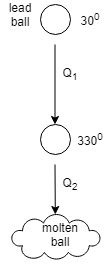Question
Question: A lead ball at \({30^0}C\) is dropped from a height of 6.2 km. The ball is heated due to the air res...
A lead ball at 300C is dropped from a height of 6.2 km. The ball is heated due to the air resistance and it completely melts just before reaching the ground. The molten substance falls slowly on the ground. If the specific heat of lead = 126JKg−1 0C−1and melting point of lead = 1300C and suppose that any mechanical energy lost is used to heat the ball, then the latent heat of fusion of lead is
A) 2.4×104JKg−1
B) 3.6×104JKg−1
C) 7.6×102JKg−1
D) 4.9×104JKg−1
E) 7.9×104JKg−1
Solution
The lead ball has some heat energy when reaching the melting point and different heat energy when it melts completely. We will find out the relation of before and after heat energy of the ball and then it is given that mechanical energy is lost to heat the ball then mgh=net heat of the ball. This will give the latent heat of fusion of the lead ball, where m is mass, g is gravity, and height of the ball.
Complete step by step answer:
Step 1:
Latent heat of fusion :- Latent heat of fusion, also known as enthalpy of fusion, is the amount of energy that must be supplied to a solid substance (typically in the form of heat) in order to trigger a change in its physical state and convert it into a liquid (when the pressure of the environment is kept constant).
We are given:
A lead ball at 300C is dropped from a height of 6.2 km
The specific heat of lead = 126JKg−1 0C−1
The point of lead = 1300C
We need to find the latent heat of fusion of lead
Let us take the help of the diagram to understand the question:

The ball when at rest has the temperature 300C and then when it is released it must have attained the temperature of 3300C and reached the ground in the molten state. Then there must be heat energy Q1 before reaching melting temperature and heat energy Q2 at the time of melting. The rise in temperature is 3000C
Step 2:
Now coming to the question:
We are not given exactly the mass of the lead ball
Then let the mass of the ball be m so, Q1=m×126×300 here, m is the mass of the ball
In the same way the Q2 =m × L where, L is the latent heat of fusion of lead
To find QNET we need to add Q1 and Q2
Adding both we get, QNET=m(126×300×L)
We are given that any mechanical energy lost is used to heat the ball then; loss in mechanical energy is equal to heat.
Then, mgh=msΔθ+mL here, g is the gravity, h is the height
Taking left hand side mgh and equating to the QNET
This will equal to m(126×300+L)=m×10×6.2×103
Here, mass will get cancel out and from there we will get L equal to 2.4×104JKg−1
Hence, the latent heat of fusion of lead is 2.4×104JKg−1
Option A is correct.
Note: Reason why we choose latent heat of fusion: The latent heat of fusion of a substance also accounts for the energy required to accommodate any increase in the volume of the substance post the change of its physical state. The temperature at which the substance undergoes the phase transition is called the melting point of the substance.
